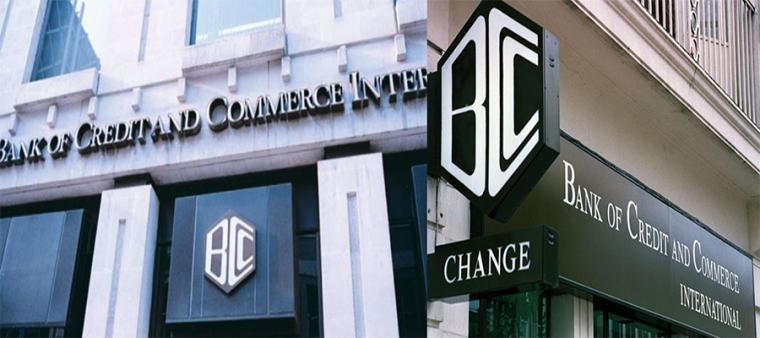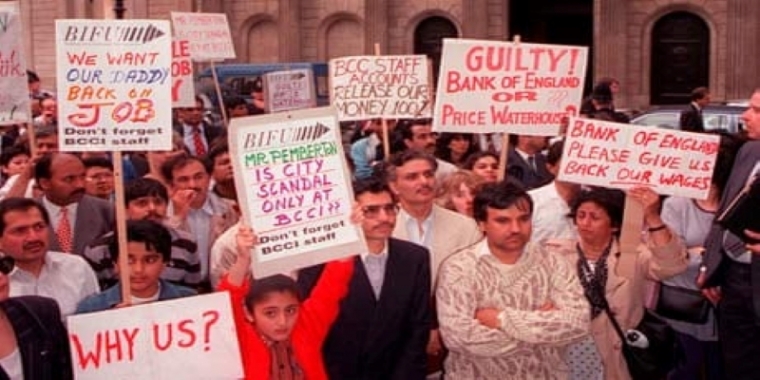BCCI Insights website is an effort to tell the story of Bank of Credit and Commerce International (BCCI), one of the largest multinational banks, through information and documents for people to freely access and form their own opinions about BCCI and the vision of the founder, Agha Hasan Abedi.
BCCI was established in 1972 and abruptly shut down by western central banks in 1991.
The website is the initiative of the BCCI Campaign Committee Trust (BCCI Campaign Committee), a not-for-profit company limited by guarantee (Company Number 13561895) registered in England & Wales, United Kingdom on 12 August 2021.
Bank of Credit and Commerce International (BCCI) became the fourth largest geographically dispersed Bank globally within a period of twenty years.
This website, for the first time, brings significantly relevant but missing information about the history of BCCI to enable the public to make a more informed judgment regarding the central allegations that BCCI was bankrupt, and "the largest bank fraud in world financial history" with a "criminal culture from top to bottom."
The narratives presented BCCI and its founder remains well coordinated uncoincidentally similar from the inception of the Bank in 1972. A synchronised campaign ensured denial of all platforms to present the BCCI’s counter-narrative version and was intended to leave a distorted impression on the public perception about BCCI and its founder, Mr Agha Hasan Abedi.
Exaggerating, sensationalising and sometimes fictionalising the story of BCCI and the founder, Mr Agha Hasan Abedi, that followed BCCI’s closure was perhaps intended that the truth about BCCI's extraordinary growth would never be known.
For example, the media and case studies repeatedly refer to BCC as a "bankrupt or collapsed" bank. Yet they offer no evidence of transactions or obligations that BCC failed to honour worldwide. This should have aroused suspicion about whether the abrupt shut-down of BCC globally may have been a grand design by the regulators, politicians and bureaucrats in the West, mainly the USA and United Kingdom.
For example, the reporting against BCCI never mention the pioneering initiatives in banking products and services, the founder's concepts of Real Management, that corporate organisations had life and the urge to live, and BCCI’s well-tested practices that the best corporate management had a "joint personality and 'Giving' to the community more than it took.
The phenomenon of BCCI is unlikely to be repeated. A bank established by bankers of the Third World with a global presence in 73 countries in 1990 with its pioneering services and marketing approach in banking. The actions by the bank regulators in the West effectively sealed the possibility of another multinational commercial bank like BCCI ever again emanating from the Third World. A bank established by the founder to serve all nations and service to humanity.
BCCI - A Case Study
Some Universities and Business Schools as well as financial institutions and discussed in reference books, present BCCI as a case study of “the biggest fraud in banking history” in line with the narrative cultivated earlier to justify the forced closure of BCCI. These case studies, however, omit to mention or make a comparative study with other proven financial frauds and money laundering and other illicit operations by large international banks in the West, that involved billions of US dollars.
References below are few of the biggest money laundering cases reported in the media and where the banks were not shut down and placed in liquidation:
- Wachovia (US$390 billion): Now part of Wells Fargo, Wachovia was one of the biggest banks in the USA. In 2010, the bank was found to have allowed drug cartels in Mexico launder close to US$390 billion through its branches during 2004-2007.
- Danske Bank (US$228 billion): Denmark's largest bank came into the limelight after the European Commission described its US$228 billion money-laundering case as the biggest scandal in Europe. Thousands of suspicious customers of the bank's Estonian branch allegedly carried out illicit transactions worth about US$228 billion during 2007-2015.
- HSBC (US$8 billion): Complaints against the British multinational bank included provision of banking services and UD dollars to some banks in Saudi Arabia with apparent connections to terrorists, circumventing international sanctions and allowing transactions involving blacklisted countries such as Iran and North Korea and improper controls at HSBC Mexico despite its apparent problems with drug trafficking and money laundering.
- Capital One Financial Corporation: Capital One, an USA bank holding company, was hit with a $290 million penalty after admitting to the U.S. Treasury Department that it wilfully violated anti-money laundering requirements between 2008 and 2014. [The bank's] failures allowed known criminals to use and abuse USA's financial system unchecked.
In 2020, thousands of documents obtained by journalists allegedly revealed trillions of dollars of dirty money being moved around the world. Over 2,100 suspicious activity reports (SARs) covering more than US$2 trillion (£1.5 trillion) in transactions were leaked to BuzzFeed News and shared with the International Consortium of Investigative Journalists (ICIJ). Five global banks were named in an investigation: JPMorgan Chase, HSBC, Standard Chartered, Deutsche Bank and Bank of New York Mellon. Covering transactions between 1999 and 2017, the SARs were leaked from the US Financial Crimes Investigation Network (FinCEN), an agency which is part of the US Treasury and tasked with tackling money laundering.
BCCI in brief
BCCI was conceived in the early 1970s by Mr Agha Hasan Abedi, who was previously the founder of United Bank Limited in Pakistan, supported by a management team of professional bankers from the Third World. Mr Abedi's vision was to establish an international banking organisation to provide banking services to all nations and providing international exposure to local banks in developing countries where the large western banks dominated.

BCCI was established in 1972 with three branches. In a short time of 18 years BCCI with its banks, subsidiaries and affiliates (BCC Group) reached the four corners of the globe, from China to Canada, from Spain to Swaziland, from Argentine to Zambia, and right across the world, encompassing 73 countries at its peak bridging five continents, with over a million customers, more than 14,000 employees covering 90 nationalities and handling global trade that exceeded $1.8 billion annually.
By 1990 BCC was ranked within the top 10 banks of the world in terms of global coverage according to the BANKER magazine, something that had taken others in that elite group of colonial banks generations to achieve. Effectively the BCC Group had become a truly "global bank" with a worldwide presence.

BCCI Closure
BCCI was abruptly shut down world-wide on 5th July 1991 under a cloud of controversy. The closure of BCCI left its million customers and thousands of its hard-working employees shell-locked and stigmatised.
There is a valid argument that BCCI was not insolvent at the time the bank was shut down when it had the financing backing of Abu Dhabi (United Arab Emirates), the bank's majority shareholders. BCCI always had liquidity to meet all its financial obligations. Compare this with most large international banks that rely on traditional inter-bank borrowing to cover the shortfall in their daily liquidity position to remain solvent.
At the close of liquidations customers who had deposited monies with BCCI received back at least 96% of their monies, while in some countries amount was 100% and said to be even more than 100%.
More shocking was the huge fees, estimated more than US$1.7 billion, charged world-wide by the accountants and lawyers 'feeding off the carcass' of BCCI leaving dispositors short-changed.
Reason for the website
The BCCI website is being painstakingly developed by the BCCI Campaign Committee Trust (the BCCI Campaign Committee, formerly the Committee Representing the Employees and Creditors), to inform the public about the activities of BCCI and the vision of the founder, Mr Agha Hasan Abedi, to establish a major international bank managed by bankers who reflected the aspirations of the people of the Third World and to also raise their profile in the international financial markets.
The website does not profess to encompass all the information on BCC. It would be an onerous, if not an impossible task, particularly many decades after BCC's controversial closure.
The bulk of the documents on the website were obtained by the BCCI Campaign Committee while litigating former employees claims against the Joint Liquidators of BCCI in London, United Kingdom, as well as information provided by former employees of BCCI and obtained from other sources.
Efforts are continuing to gather additional information, documents and personal recollections for the website in so far it is practical to do so. Invariably, there will remain gaps in the website content that are unlikely to be filled.
The website will attempt to also provide a perspective analysis on key allegations made in The BCCI Affair: A Report to the Committee on Foreign Relations United States by Senator John Kerry and Senator Hank Brown December 1992, and in several books published post-BCCI closure to justify the shutdown of BCC world-wide.
Contribute to content
Contributions for the website may be in different forms, such as BCCI magazines, internal reports and memos, instruction circulars, procedure and policy manuals, letters, minutes of meetings, personal recollections, essays, theses, photos, and articles published locally, audio and video recordings. Contact
Financial Support
Contribute by giving to continue development of the website. Give
